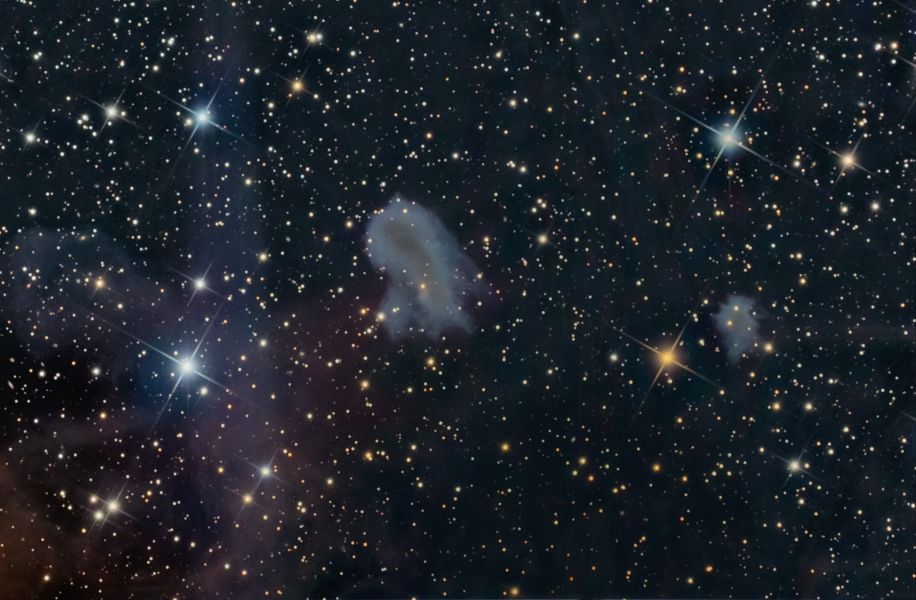IC 423 and IC 424, Reflection Nebulae in Orion |
 |
| When I shot IC 426 back in 2009, it was actually a "consolation prize",
as
my desired target back then was actually IC423 and its little
companion, IC 424 to its right. But as other experienced amateur
imagers will understand, I was challenged at the time to fine a
proper guide star, and "made do" with IC 426, which turned out
to be even less imaged than this pair - I had selected them as
targets, inspired by another post in a forum of this pair. Fast forward to 2015, when I finally had a setup that could image this pair with a proper guide star, but also with a wider field of view, and this is the result. These objects are similar to IC 426 in that they are reflection nebulae that do not glow on their own, but reflect light from bright stars in their vicinity. These objects are likely similar to IC 426 in composition and density: 10 billion molecules per cubic meter, which is still one trillionth the density of Earth's atmosphere. Their teardrop shapes (in fact, IC 423 is nicknamed the Teardrop Nebula) could be caused by the stellar winds of the same stars that are the possible source of the light they are reflecting: Alnilam and Mintaka, two of the stars in Orion's belt. There is a of IC 423 going back to an image taken with the Crossley reflector and published in 1918 which reads: "A very peculiar and interesting mass of diffuse nebulosity, 6' x 4'. The central part is vacant, giving the object the general appearance of a pear-shaped ring, rounded at the southern end and pointed at the northern end, which is directed approximately toward {delta} Orionis, 27' distant. There are flame-like protuberances on each side at the north. Quite faint." Similarly, IC 424 is described by the paper as: "A smaller mass of diffuse nebulosity, somewhat resembling I 423; 2.5' x 1'; the sharper western end points to {delta} Orionis, 24' distant." Both objects were discovered by Williamina Fleming on June 27, 1888. A short bio of her reads: "Scottish-American astronomer. Abandoned by her husband, she was reduced to working as a maid. Her employer, a professor of astronomy at Harvard, was so dissatisfied with the work of his assistants that he claimed "My maid could do a better job." And she did, becoming one of the most famous female astronomers of the 19th century, and an honorary member of the Royal Astronomical Society." Source of last three paragraphs: Rick Johnson |
| Constellation: Orion |
| When Visible: December - April |
| Distance: 1,500 Light-years |
| Date: January to March, 2015 |
| Location: Rancho Hidalgo, Animas, NM |
| Exposure Details:
L: 37 x 10 Minutes Binned 1x1 R: 25 x 10 Minutes Binned 1x1 G: 25 x 10 Minutes Binned 1x1 B: 25 x 10 Minutes Binned 1x1 |
| Equipment Used: 12.5" PlaneWave CDK on a Software Bisque Paramount ME mount. SBIG STL-6303 camera with 5-position filter wheel, AO-L Adaptive Optics Unit, Pyxis Rotator and Astrodon LRGB filters |
| Acquisition Software : MaximDL, TheSky6, CCDAutopilot |
| Processing Software: MaximDL, Adobe Photoshop CS5, Carboni Tools, IrFanView |
